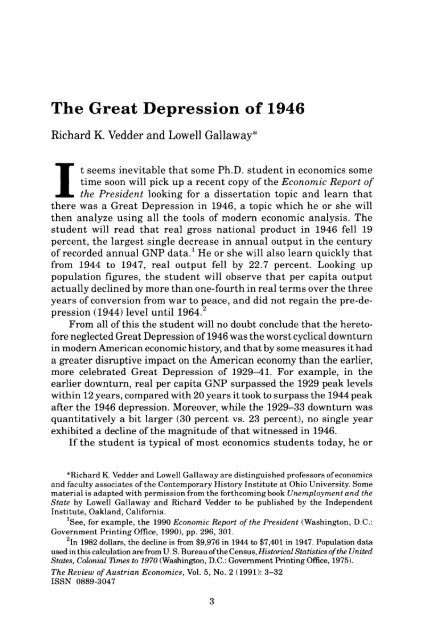Review of Austrian Economics - The Ludwig von Mises Institute
Review of Austrian Economics - The Ludwig von Mises Institute
Review of Austrian Economics - The Ludwig von Mises Institute
Create successful ePaper yourself
Turn your PDF publications into a flip-book with our unique Google optimized e-Paper software.
<strong>The</strong> Great Depression <strong>of</strong> 1946<br />
Richard K. Vedder and Lowell Gallaway*<br />
It seems inevitable that some Ph.D. student in economics some<br />
time soon will pick up a recent copy <strong>of</strong> the Economic Report <strong>of</strong><br />
the President looking for a dissertation topic and learn that<br />
there was a Great Depression in 1946, a topic which he or she will<br />
then analyze using all the tools <strong>of</strong> modern economic analysis. <strong>The</strong><br />
student will read that real gross national product in 1946 fell 19<br />
percent, the largest single decrease in annual output in the century<br />
<strong>of</strong> recorded annual GNP data. 1 He or she will also learn quickly that<br />
from 1944 to 1947, real output fell by 22.7 percent. Looking up<br />
population figures, the student will observe that per capita output<br />
actually declined by more than one-fourth in real terms over the three<br />
years <strong>of</strong> conversion from war to peace, and did not regain the pre-depression<br />
(1944) level until 1964. 2<br />
From all <strong>of</strong> this the student will no doubt conclude that the heret<strong>of</strong>ore<br />
neglected Great Depression <strong>of</strong> 1946 was the worst cyclical downturn<br />
in modern American economic history, and that by some measures it had<br />
a greater disruptive impact on the American economy than the earlier,<br />
more celebrated Great Depression <strong>of</strong> 1929—41. For example, in the<br />
earlier downturn, real per capita GNP surpassed the 1929 peak levels<br />
within 12 years, compared with 20 years it took to surpass the 1944 peak<br />
after the 1946 depression. Moreover, while the 1929-33 downturn was<br />
quantitatively a bit larger (30 percent vs. 23 percent), no single year<br />
exhibited a decline <strong>of</strong> the magnitude <strong>of</strong> that witnessed in 1946.<br />
If the student is typical <strong>of</strong> most economics students today, he or<br />
*Richard K. Vedder and Lowell Gallaway are distinguished pr<strong>of</strong>essors <strong>of</strong> economics<br />
and faculty associates <strong>of</strong> the Contemporary History <strong>Institute</strong> at Ohio University. Some<br />
material is adapted with permission from the forthcoming book Unemployment and the<br />
State by Lowell Gallaway and Richard Vedder to be published by the Independent<br />
<strong>Institute</strong>, Oakland, California.<br />
^ee, for example, the 1990 Economic Report <strong>of</strong> the President (Washington, D.C.:<br />
Government Printing Office, 1990), pp. 296, 301.<br />
2 In 1982 dollars, the decline is from $9,976 in 1944 to $7,401 in 1947. Population data<br />
used in this calculation are from U. S. Bureau <strong>of</strong> the Census, Historical Statistics <strong>of</strong> the United<br />
States, Colonial Times to 1970 (Washington, D.C.: Government Printing Office, 1975).<br />
<strong>The</strong> <strong>Review</strong> <strong>of</strong> <strong>Austrian</strong> <strong>Economics</strong>, Vol. 5, No. 2 (1991): 3-32<br />
ISSN 0889-3047

















